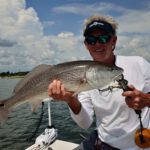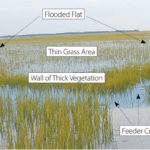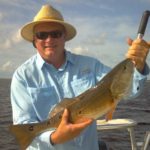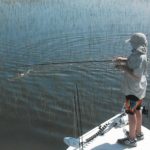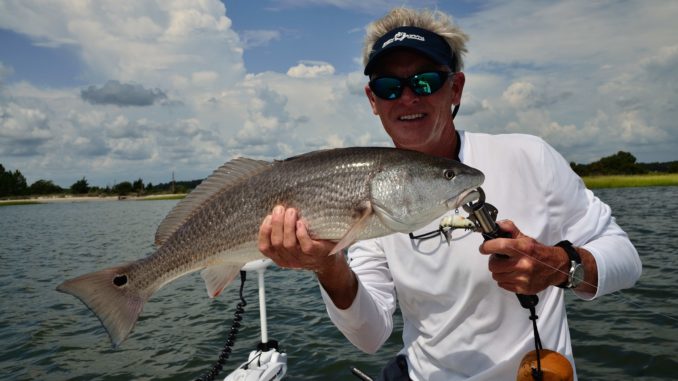
Forget low tide, high water brings out the tailing reds in the Little River marshes.
Surrounded by high-rise hotels, gambling vessels and sand castles lay the spartina-covered marshes of Little River, and while they may appear limited in size, the grassy jungles are just what the doctor ordered for South Carolina’s coveted redfish, aka spot-tail bass. Anglers willing to adopt a different tactic can have full access to these waters on the high end of the tidal cycle.
The maze of back channels through the marsh grass and oyster beds is perfect habitat for spot-tails. For most anglers, low-water conditions are favored for reds because fish are confined to smaller areas where they, along with baitfish, crabs and shrimps, are funneled. However, many of these low-tide places can be isolated from many boaters, and fish are in a defensive mode anyway, looking for every sign and sound of danger.
But there is another way.
While often avoided, high-tide conditions can offer opportunities to connect with a drag-screaming spot-tail. First off, the fish are more comfortable. When more water is available, fish are able to stretch out and maneuver all over the shallow marshes in search of food. One drawback is the small baitfish and shrimp have more places to hide from patrolling reds. In order for spot-tails to eat, they need to be more aggressive, and that gives anglers an advantage.
Greg Holmes of Fish Skinny Charters fish every phase of the tide for spot-tails, including the high-water periods. Since fish can be almost anywhere across the flooded marshes, Holmes looks for a natural or unnatural feature to confine the fish.
“I look for places where there is sparse grass bordered by a hard edge,” Holmes said. “Just like when you are walking on a city sidewalk, you are going to turn and follow the sidewalk, and fish do the same thing.”
Sparsely vegetated areas protect spot-tails from larger predators and serve as a travel corridor for baitfish, creating perfect ambush opportunities for predators. Holmes likes to find these areas close to deeper channels. Bonaparte, East River, Dunn Sound Creek, Calabash Creek, Little River and the ICW itself all provide opportunities to find cruising spot-tails on high water.
Even in the small Little River region, acres and acres habitat can meet these criteria. The regular places that Holmes fishes with success all have one feature in common.
“Spot-tails love to stay close to oyster and shell beds,” he said, because the shells are ideal structure to hide small crustaceans and baitfish. Large oyster mounds adjacent to the grass edges are great, but even a small oyster cluster no bigger than a few square yards will attract spot-tails.
“If you have a good oyster bed next to the grass, the fish will not stray too far. I like to float a live shrimp over the top of the oyster beds, too. You will frequently pick up a cruiser on top of the oysters,” Holmes said.
While oyster mounds close to grass edges are prime locations, they can be tough to see when the water is high, which is why Mark Dickson of Shallow Minded Fishing Charters puts in his time during periods of low water.
“It takes a lot of work behind the scenes to find a great place to fish,” Dickson said. “You have to do your homework.”
On low water, oyster beds and creek channels are visible and distinguishable. Dickson fishes the scattered grass over oyster shells on high water, but he will set up near the feeder tributaries, especially when the water begins to ebb.
“They will hang out where the mullet comes off the flats and into the small ditches leading back to the deep water. If you do your homework, you can see all of these places on lower water,” Dickson said.
Since fish are constantly on the move during periods of high water, anglers should use something that will attract them from a distance. Dickson will fish four to five rods with cut mullet or a chunk of blue crab to get out some scent.
“If there are any fish up there, they will find it,” he said.
Typically, on the high end of the tide, green ocean water will flush back into the marshes, providing clear-water conditions. Fish can see a long way, creating an ideal situation for anglers to use a wide variety of artificial lures.
“I like to use gold spoons and spinnerbaits on cruiser fish. Throw something you can pull through the water,” Dickson said.
Areas of sparse grass can be good spots to test out a wide variety of lures that imitate small mullet and shrimp, drawing the attention of spot-tails with good action and movement. Since most casts are being made into the grass, weedless options are preferred. Swimbaits and other soft plastics rigged on flutter hooks are good options.
Egret’s Wedgetail Mullet and Wedgetail Eel are heavy soft plastics with tails made to mimic the lifelike action of a baitfish and provide vibration that will pull fish from long distances. The tail design will emit vibrations that the spot tails will key-in on at a long distance away. Gulp’s ripple mullet and Category Five’s Manic Minnow have similar tail designs and are killer soft plastics fished weedless through the grass.
Live bait is still a good option. In September and October, waters are filled with tons of finger mullet and shrimp, which are tough to be beat hooked up. A finger mullet carrying a circle hook through its lips will give off a lot of flash and vibration.
“I love wigglies! The action of the live bait is a deadly combination in clear water,” Holmes said.
As fall arrives, spot-tail action heats up. Water temperatures begin their annual decent, and tons of baitfish look for places to hide. Anglers conditioned to fish under low-tide conditions for a short time are missing out on the rest of the day, when water is higher and fish are less spooky. Whether using live, dead or artificial baits, the beginning of fall fishing is an ideal time to hook up with a limit of spot-tail bass in Little River’s marshes.
DESTINATION INFORMATION
HOW TO GET THERE — The Little River estuary along the state line is easily accessed from the two public boat ramps: one under the US 17 bridge across the Intracoastal Waterway in North Myrtle Beach and the other at Sunset Beach. Visit www.dnr.sc.gov/pubs/boatfacilities.pdf for exact locations. Productive fishing areas include the marshes between Sunset Beach, Calabash and Cherry Grove. Look for grass edges and marsh that abuts small islands that rarely flood. Also, look at spoil islands along the ICW, which provide excellent opportunities on the high end of the tide.
WHEN TO GO — Redfish live in the flooded marsh most of the year. The best tailing action is during the summer and early fall when the water temperature is higher than 60 degrees. Falling water temperatures will invigorate redfish feeding activity, giving anglers good fishing from September into early December.
BEST TECHNIQUES — Live or cut mullet fished on a jighead or light Carolina rig is hard to beat on a flood tide or a normal high tide in the grass. Live shrimp fished under a float are productive on the outer edges of the grass. Any artificial bait infused with scent can be productive fished in the grass or shallows rigged weedless. Braided line is preferred, with 20-pound test required around the grass, tied to an 18- to 24-inch section of 20-pound fluorocarbon leader because of water clarity. Sensitive rods are a major advantage; many fishermen use medium-action spinning outfits in 7-foot lengths for casting light lures long distances.
FISHING INFO/GUIDES — Capt. Greg Holmes, Fish Skinny Charters, 843-241-0594, www.fishskinnycharters.com; Capt. mark Dickson, Shallow-Minded Fishing Charters, 843-458-3055, www.fishmyrtlebeach.com.
ACCOMMODATIONS — Hampton Inn-North Myrtle Beach Harbourgate, 843-249-1997; Myrtle Beach Area Convention and Visitors Bureau, www.mbchamber.com, South Carolina Association of Visitors Bureaus, www.discoversouthcarolina.com.
MAPS — Capt. Segull’s Nautical Charts, 888-473-4855, www.captainsegullcharts.com; DeLorme’s S.C. Atlas & Gazetteer, 207-846-7000, www.delorme.com; Navionics, 800-848-5896, www.navionics.com, 800-848-5896.

